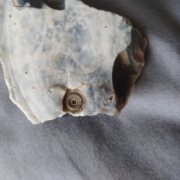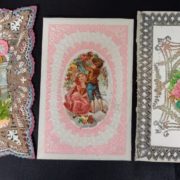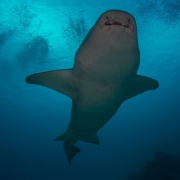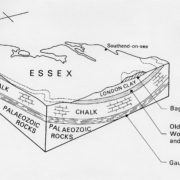Identification – Sea urchin fossil
Did you know we identify items for free? Whether it’s a rock from a field or a mystery something from the back of the shed, just bring it in to the Museum and we’ll take care of the rest! (If it’s too big or heavy, just send us an email with a photo).
This piece of flint with a strange marking on it was found in Wethersfield, near Braintree.

The flint nodule has preserved the impression of part of a sea urchin, or echinoid (pronounced ek-in-oid).
The shape you see is the external mould of a single plate of the echinoid’s ‘test’, or shell. When a sea urchin dies or is eaten, the test will often break apart into the individual plates.
Flint is formed from a silica-rich goo which hardens over time, and must have formed on top of this echinoid plate and taken its shape. The plates are made from calcium carbonate and this one will have dissolved away over time, leaving the impression behind.
The shape of the plate suggests it belongs to a species in the genus Cidaris. Saffron Walden Museum has a similar echinoid, Stereocidaris sceptrifera, fossilised in chalk, on display as no. 23 in the How Did They Live display in the geology gallery (below, top). In life, the club-like spines would have been attached to the plates. One of the Museum’s volunteers took this photo of a similar echinoid found at a chalk pit in Grays, Essex (below, bottom).

Fossil in chalk of the extinct sea urchin Stereocidaris sceptrifera, on display in the Museum’s geology gallery. SAFWM : 2020.42.23

The plate in the flint nodule (and the plates in the photos) is an interambulacral plate, which make up most the test of a sea urchin. They fill the space between the ambulacral zones, which are the areas where the urchin’s tube feet pass through the test. Tube feet are used for movement and to exchange oxygen and carbon dioxide with the water for respiration. Sea urchins have 5 ambulacra arranged in a star shape, showing that they are related to starfish.
The Natural History Museum has a good page showing the structure of a sea urchin test: https://www.nhm.ac.uk/our-science/data/echinoid-directory/morphology/regulars/intro.html
The British Geological Survey has an interesting page with good photos of similar fossil echinoids – look out for Temnocidaris (Stereocidaris) sceptrifera about halfway down, and Heterocidaris wickense at the bottom: https://www.bgs.ac.uk/discovering-geology/fossils-and-geological-time/echinoids/
Another link to the NHM with photos of Stereocidaris fossils: https://www.nhm.ac.uk/our-science/data/echinoid-directory/taxa/taxon.jsp?id=1115










